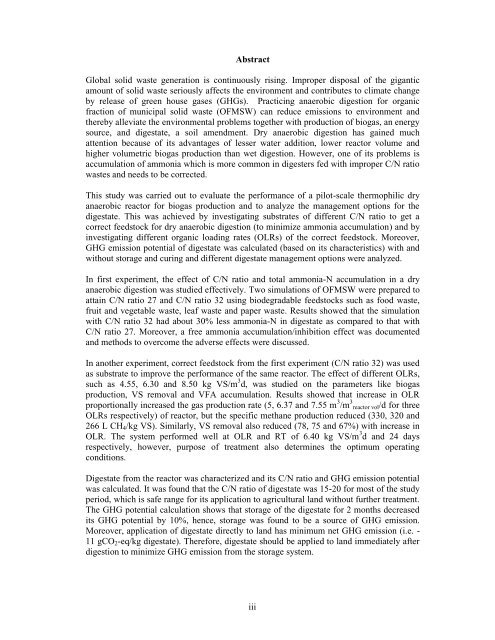dry anaerobic digestion of municipal solid waste and digestate ...
dry anaerobic digestion of municipal solid waste and digestate ...
dry anaerobic digestion of municipal solid waste and digestate ...
You also want an ePaper? Increase the reach of your titles
YUMPU automatically turns print PDFs into web optimized ePapers that Google loves.
Abstract<br />
Global <strong>solid</strong> <strong>waste</strong> generation is continuously rising. Improper disposal <strong>of</strong> the gigantic<br />
amount <strong>of</strong> <strong>solid</strong> <strong>waste</strong> seriously affects the environment <strong>and</strong> contributes to climate change<br />
by release <strong>of</strong> green house gases (GHGs). Practicing <strong>anaerobic</strong> <strong>digestion</strong> for organic<br />
fraction <strong>of</strong> <strong>municipal</strong> <strong>solid</strong> <strong>waste</strong> (OFMSW) can reduce emissions to environment <strong>and</strong><br />
thereby alleviate the environmental problems together with production <strong>of</strong> biogas, an energy<br />
source, <strong>and</strong> <strong>digestate</strong>, a soil amendment. Dry <strong>anaerobic</strong> <strong>digestion</strong> has gained much<br />
attention because <strong>of</strong> its advantages <strong>of</strong> lesser water addition, lower reactor volume <strong>and</strong><br />
higher volumetric biogas production than wet <strong>digestion</strong>. However, one <strong>of</strong> its problems is<br />
accumulation <strong>of</strong> ammonia which is more common in digesters fed with improper C/N ratio<br />
<strong>waste</strong>s <strong>and</strong> needs to be corrected.<br />
This study was carried out to evaluate the performance <strong>of</strong> a pilot-scale thermophilic <strong>dry</strong><br />
<strong>anaerobic</strong> reactor for biogas production <strong>and</strong> to analyze the management options for the<br />
<strong>digestate</strong>. This was achieved by investigating substrates <strong>of</strong> different C/N ratio to get a<br />
correct feedstock for <strong>dry</strong> <strong>anaerobic</strong> <strong>digestion</strong> (to minimize ammonia accumulation) <strong>and</strong> by<br />
investigating different organic loading rates (OLRs) <strong>of</strong> the correct feedstock. Moreover,<br />
GHG emission potential <strong>of</strong> <strong>digestate</strong> was calculated (based on its characteristics) with <strong>and</strong><br />
without storage <strong>and</strong> curing <strong>and</strong> different <strong>digestate</strong> management options were analyzed.<br />
In first experiment, the effect <strong>of</strong> C/N ratio <strong>and</strong> total ammonia-N accumulation in a <strong>dry</strong><br />
<strong>anaerobic</strong> <strong>digestion</strong> was studied effectively. Two simulations <strong>of</strong> OFMSW were prepared to<br />
attain C/N ratio 27 <strong>and</strong> C/N ratio 32 using biodegradable feedstocks such as food <strong>waste</strong>,<br />
fruit <strong>and</strong> vegetable <strong>waste</strong>, leaf <strong>waste</strong> <strong>and</strong> paper <strong>waste</strong>. Results showed that the simulation<br />
with C/N ratio 32 had about 30% less ammonia-N in <strong>digestate</strong> as compared to that with<br />
C/N ratio 27. Moreover, a free ammonia accumulation/inhibition effect was documented<br />
<strong>and</strong> methods to overcome the adverse effects were discussed.<br />
In another experiment, correct feedstock from the first experiment (C/N ratio 32) was used<br />
as substrate to improve the performance <strong>of</strong> the same reactor. The effect <strong>of</strong> different OLRs,<br />
such as 4.55, 6.30 <strong>and</strong> 8.50 kg VS/m 3 d, was studied on the parameters like biogas<br />
production, VS removal <strong>and</strong> VFA accumulation. Results showed that increase in OLR<br />
proportionally increased the gas production rate (5, 6.37 <strong>and</strong> 7.55 m 3 /m 3 reactor vol/d for three<br />
OLRs respectively) <strong>of</strong> reactor, but the specific methane production reduced (330, 320 <strong>and</strong><br />
266 L CH4/kg VS). Similarly, VS removal also reduced (78, 75 <strong>and</strong> 67%) with increase in<br />
OLR. The system performed well at OLR <strong>and</strong> RT <strong>of</strong> 6.40 kg VS/m 3 d <strong>and</strong> 24 days<br />
respectively, however, purpose <strong>of</strong> treatment also determines the optimum operating<br />
conditions.<br />
Digestate from the reactor was characterized <strong>and</strong> its C/N ratio <strong>and</strong> GHG emission potential<br />
was calculated. It was found that the C/N ratio <strong>of</strong> <strong>digestate</strong> was 15-20 for most <strong>of</strong> the study<br />
period, which is safe range for its application to agricultural l<strong>and</strong> without further treatment.<br />
The GHG potential calculation shows that storage <strong>of</strong> the <strong>digestate</strong> for 2 months decreased<br />
its GHG potential by 10%, hence, storage was found to be a source <strong>of</strong> GHG emission.<br />
Moreover, application <strong>of</strong> <strong>digestate</strong> directly to l<strong>and</strong> has minimum net GHG emission (i.e. -<br />
11 gCO2-eq/kg <strong>digestate</strong>). Therefore, <strong>digestate</strong> should be applied to l<strong>and</strong> immediately after<br />
<strong>digestion</strong> to minimize GHG emission from the storage system.<br />
iii

















